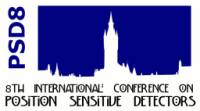Speaker
Dr
Anton Tremsin
Description
Neutron counting detectors with boron or gadolinium doped microchannel plates (MCPs) proved to have very high detection efficiency, spatial and temporal resolution and have very low readout noise. In this paper we present the results of both theoretical predictions and experimental evaluations of detection efficiency and spatial resolution measured at cold and thermal neutron beamlines. The quantum detection efficiency of not fully optimized detector was measured to be 45% and 14% for the cold and thermal beamlines, respectively. The experiments also demonstrate that the spatial resolution can be as high as sub-15 um - highest achievable with the particular MCP pore dimension used in the experiment, although more electronics development is required in order to increase the counting rate capabilities of those 15 um resolution devices. The timing accuracy of neutron detection is on the scale of few us and is limited by the neutron absorption depth in the detector. The good agreement between the predicted and measured performance allows the optimization of the detector parameters in order to achieve the highest spatial resolution and detection efficiency in the future devices.

